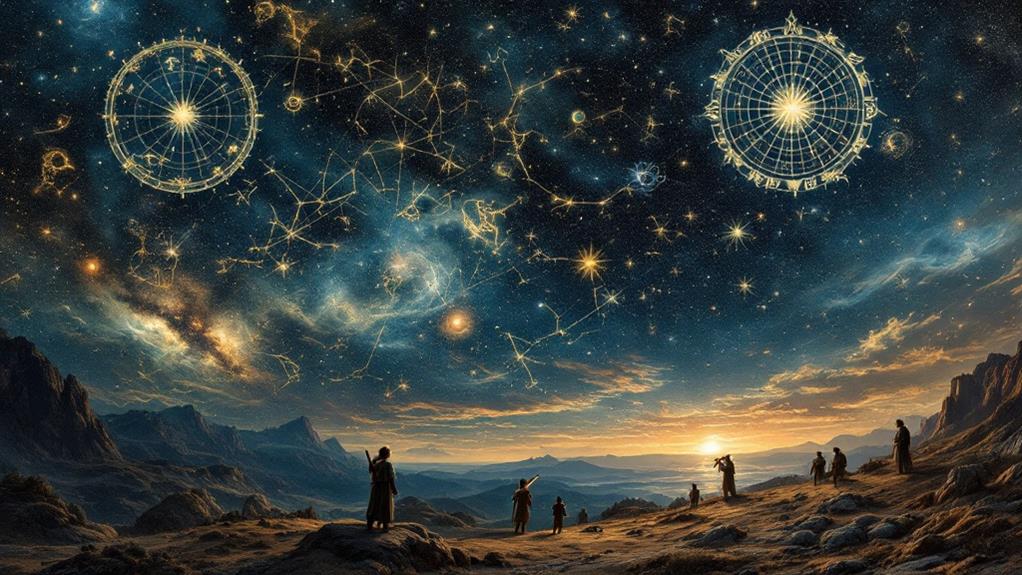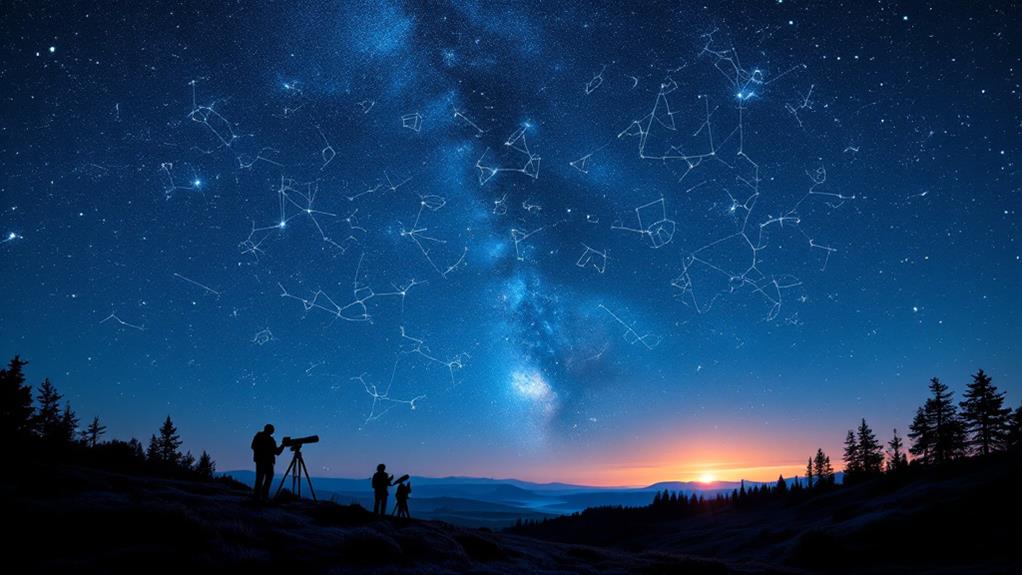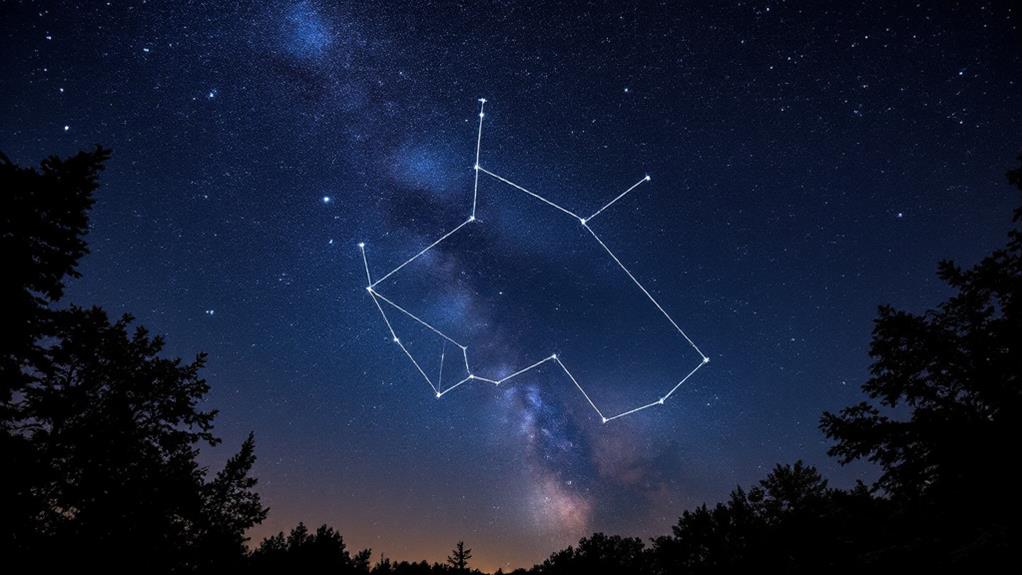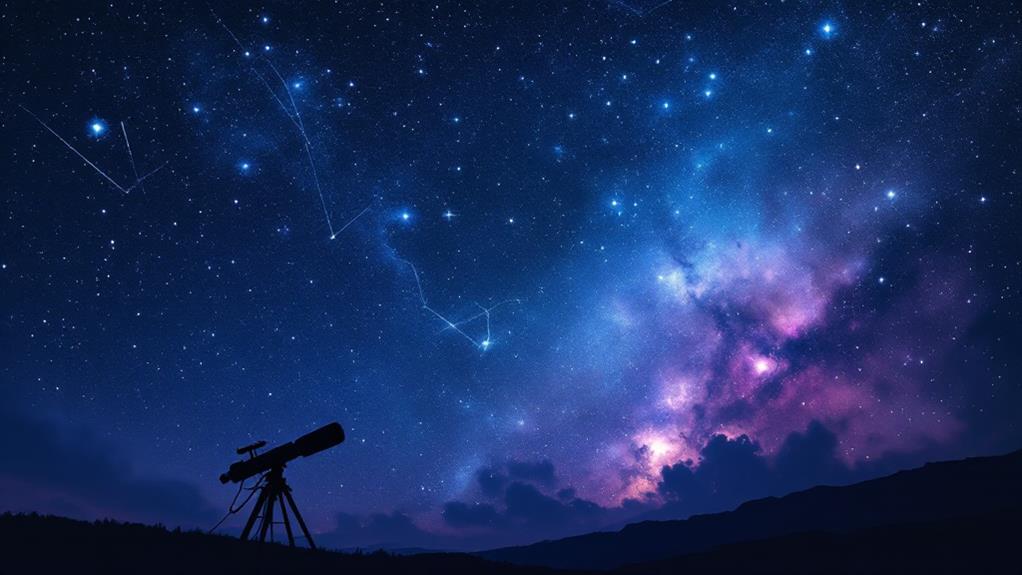Who Discovered the Constellation Virgo and When?
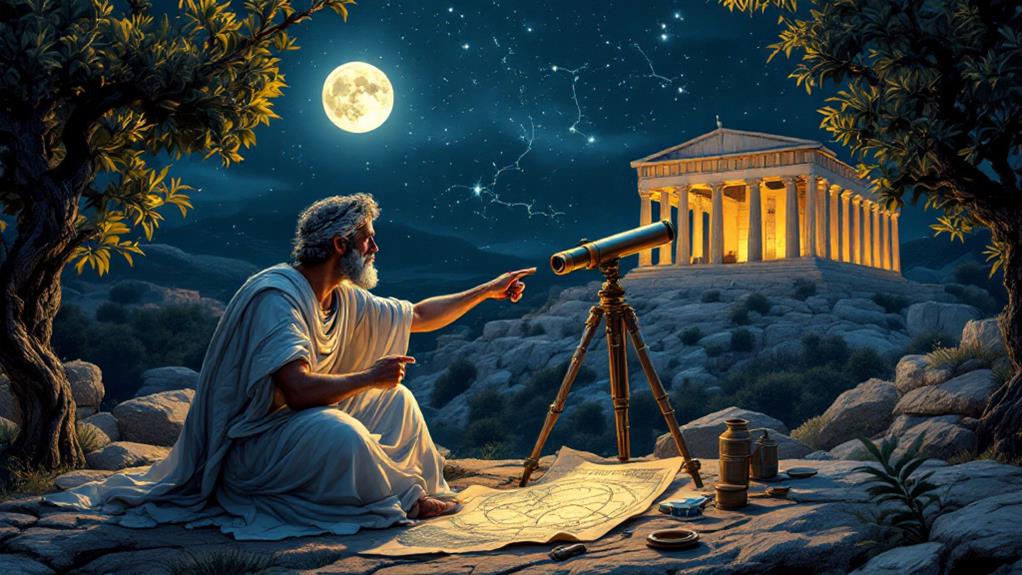
You can't attribute the discovery of Virgo to a single person or time. This constellation has been recognized by various cultures for millennia. Ancient Mesopotamians first documented Virgo around 3000 BCE, with Babylonian star catalogs providing early written evidence around 1000 BCE. Egyptians associated it with Isis, while Greeks linked it to goddesses like Demeter and Astraea. Romans connected Virgo to Ceres, and Chinese astronomers divided its area into distinct constellations. Throughout history, Virgo has played significant roles in astrology, agriculture, and religion. Exploring its rich cultural heritage reveals fascinating perspectives into human celestial observations across civilizations.
Ancient Mesopotamian Origins
The origins of Virgo as a recognized constellation stretch back to ancient Mesopotamia. You'll find that the earliest records of this celestial pattern come from Sumerian celestial observations dating back to around 3000 BCE. These ancient stargazers were among the first to identify and name the stars that make up Virgo. The Catatumbo lightning phenomenon in Venezuela, with its high concentration of lightning strikes, may have provided ancient Mesopotamians with a celestial inspiration for the constellation.
Babylonian star catalogs, such as the MUL.APIN, which dates back to around 1000 BCE, provide some of the earliest written evidence of Virgo's recognition as a distinct star pattern. These catalogs precisely documented the positions and movements of celestial bodies, including the stars that form Virgo. This early identification and documentation laid the groundwork for future astronomers and cultures to build upon, eventually leading to Virgo's inclusion in the 88 modern constellations recognized today.
Egyptian Astronomical Records
Moving from Mesopotamia to the banks of the Nile, we encounter another ancient civilization that recognized Virgo in the night sky. The Egyptians, known for their advanced astronomical knowledge, left behind precious records of their celestial observations. The Egyptians associated the constellation with their goddess Isis, often portrayed holding a shaft of wheat – a symbol closely tied to Virgo's imagery. Additionally, the Egyptians observed the different types of clouds that appeared in the sky, noting their distinct characteristics and how they were formed.
Egyptian temple records, particularly those from Dendera and Esna, showcase intricate zodiacal ceilings that feature Virgo among other constellations. These architectural marvels not only serve as artistic expressions but also as astronomical calendars and religious symbols.
While the Egyptians didn't "discover" Virgo in the modern sense, they significantly contributed to its documentation and cultural relevance. Their observations, recorded in astronomical papyri, helped refine the constellation's position and appearance. This information was later passed on to Greek and Roman astronomers, further solidifying Virgo's place in the classical zodiac we recognize today.
Greek Mythology and Virgo
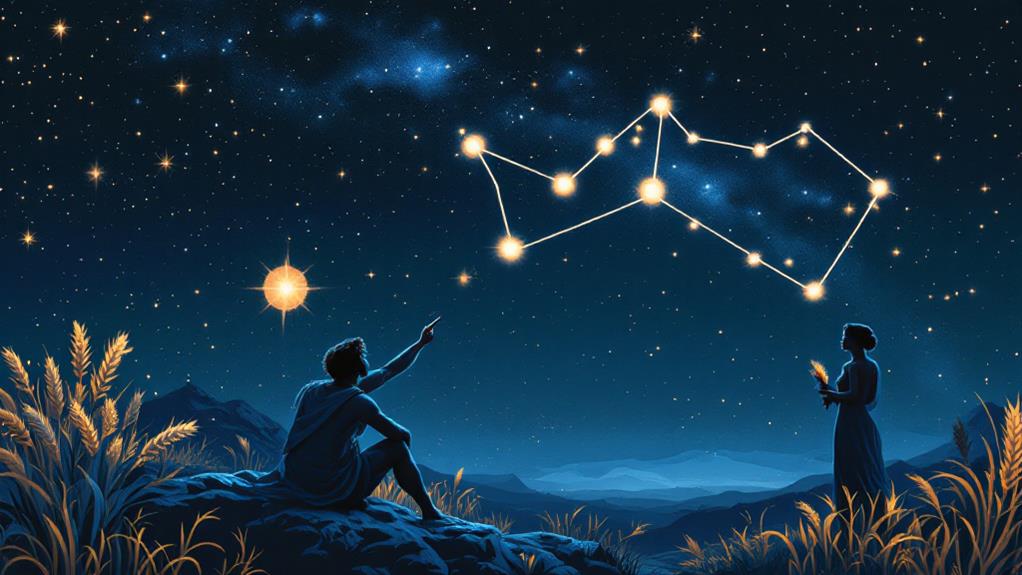
Greek mythology weaves a rich fabric of stories around Virgo, solidifying the constellation's place in Western culture. You'll find that ancient Greeks associated Virgo with several goddesses, including Demeter, the goddess of fertility and agricultural harvests. This connection stems from Virgo's visibility during the harvest season, linking the constellation to abundance and prosperity.
In another interpretation, you'll uncover Virgo representing Persephone, Demeter's daughter. The myth tells of Persephone's abduction by Hades, god of the underworld, and her cyclical return to Earth. This story explains the changing seasons, with Virgo's appearance in the sky signaling the return of spring and bountiful harvests.
You'll also encounter associations between Virgo and Astraea, the goddess of justice. According to legend, Astraea was the last immortal to abandon Earth during the Iron Age, retreating to the heavens to become the constellation Virgo. This tale imbues Virgo with qualities of purity and righteousness, reinforcing its importance in Greek mythology and subsequent Western astrological traditions.
Roman Interpretations
Roman interpretations of Virgo built upon and adapted Greek mythology, infusing the constellation with their own cultural significance. You'll find that the Romans associated Virgo with several goddesses, most remarkably Ceres, the goddess of agriculture and fertility. This connection emphasized Virgo's importance in Roman goddess worship and agricultural cycles.
In Roman astrological symbolism, Virgo retained its association with harvest and abundance. You'll notice that the Romans often represented Virgo holding a sheaf of wheat, reinforcing its connection to the land and crops. This imagery became central to Roman interpretations of the constellation.
The Romans also linked Virgo to Astraea, the goddess of justice and purity. This association added layers of meaning to the constellation, representing not only agricultural abundance but also moral virtue and cosmic order. You'll see that this varied interpretation influenced Roman art, literature, and religious practices.
Roman astrologers further developed the astrological significance of Virgo, attributing specific personality traits and life events to those born under this sign. This practice continues to influence modern Western astrology, demonstrating the lasting impact of Roman interpretations on our understanding of Virgo.
Middle Eastern Stargazing Traditions
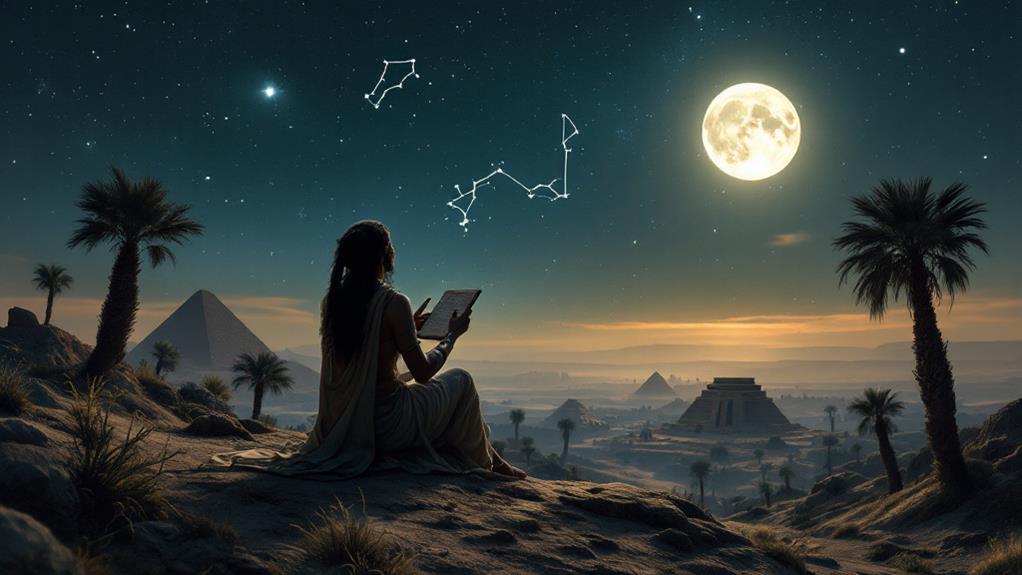
Middle Eastern stargazing traditions frequently incorporated Virgo into their celestial lore, though with distinct interpretations. You'll find that ancient Babylonian astronomers were particularly fascinated by this constellation, associating it with their goddess Ishtar. They meticulously observed Virgo's movements and used it to predict lunar eclipse patterns.
In ancient Egypt, you'd see Virgo linked to the goddess Isis, who embodied fertility and motherhood. Egyptian astronomers tracked Virgo's heliacal rising to mark the start of their agricultural year, tying the constellation closely to seasonal agricultural cycles.
Arabic astronomy later built upon these earlier traditions, referring to Virgo as Al-Adhra, meaning "the Virgin." You'd discover that Arab astronomers:
- Developed detailed star catalogs featuring Virgo's brightest stars
- Used Virgo's position to refine their understanding of planetary motions
- Incorporated the constellation into their navigational techniques for desert travel
As you explore Middle Eastern stargazing traditions, you'll notice how Virgo served as an essential celestial marker across cultures. Its prominence in the night sky made it a valuable tool for timekeeping, agriculture, and religious practices throughout the region.
Chinese Celestial Observations
China's ancient astronomers had their own unique viewpoint on the stars we now associate with Virgo. They didn't see a maiden in the sky but instead divided the area into several distinct constellations. You'll find that their celestial mapping techniques were quite sophisticated for their time.
In Chinese astronomy, the stars of Virgo were part of a larger region called the Azure Dragon. Within this area, they identified constellations such as the Horn, Stomach, and Heart. These corresponded to different parts of Virgo as we know it today. The star Spica, Virgo's brightest, was known as Jiao Xiu, meaning "horn star."
Ancient celestial diaries from China reveal thorough observations of these star patterns. Astronomers tracked their movements and used them for agricultural and ritual purposes. They'd note when certain stars appeared at dusk or dawn, helping to mark the changing seasons. This system was deeply integrated into Chinese culture and governance, influencing everything from planting crops to imperial decision-making. The Chinese approach to Virgo's stars showcases how different cultures can interpret the same celestial canvas in unique ways.
Virgo in Medieval Europe
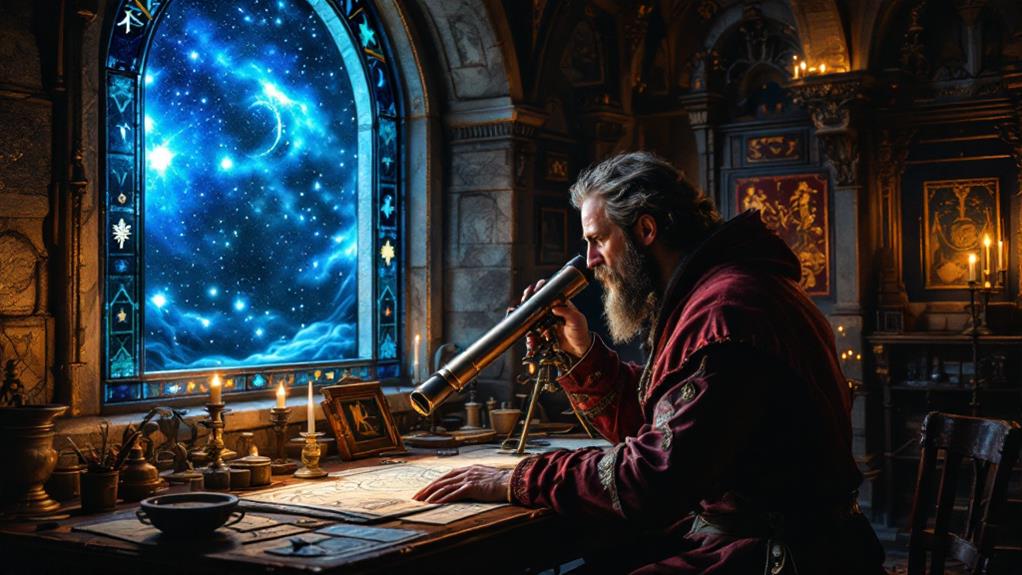
While ancient cultures had their own interpretations of the stars, Europe's medieval period saw a renewed interest in Virgo. You'll find that during this time, constellation symbolism played a significant role in various aspects of life, including astrology, agriculture, and religion. Virgo, often represented as a maiden holding wheat, became associated with the Virgin Mary in Christian iconography.
Medieval literature frequently referenced Virgo, incorporating the constellation into poetry, allegories, and morality tales. You'll encounter Virgo in works by notable authors like Dante Alighieri and Geoffrey Chaucer. The constellation's symbolism evolved to represent:
- Purity and virtue
- Harvest and fertility
- Divine wisdom and justice
As astronomy advanced during the Middle Ages, you'd see more accurate star charts and celestial observations. Virgo's position in the zodiac made it an essential constellation for timekeeping and wayfinding. Scholars and religious figures alike studied the stars, contributing to a growing body of knowledge about Virgo and other constellations. This period laid the foundation for future astronomical revelations and our modern understanding of the night sky.
Renaissance Astronomy Advancements
The Renaissance ushered in a novel phase of astronomical revelation, propelling our comprehension of Virgo and other constellations to unparalleled heights. As you explore this era, you'll uncover that astronomers developed more sophisticated astronomical techniques, allowing for more precise observations of celestial bodies. These advancements led to a deeper understanding of Virgo's position and movement across the night sky.
During this period, you'd have witnessed significant improvements in calendar development, which were closely tied to astronomical observations. The more accurate tracking of Virgo's position throughout the year played an integral role in refining timekeeping methods. You'd have seen the introduction of new instruments like the telescope, which revolutionized stargazing and permitted the identification of previously unseen celestial objects within Virgo's boundaries.
Renaissance astronomers also began to challenge ancient beliefs about the cosmos, establishing the groundwork for a more scientific approach to understanding Virgo and other constellations. You'd have encountered new star catalogs and celestial maps that provided more detailed information about Virgo's stars and their relative positions, greatly enhancing our knowledge of this ancient constellation.
Modern Scientific Understanding
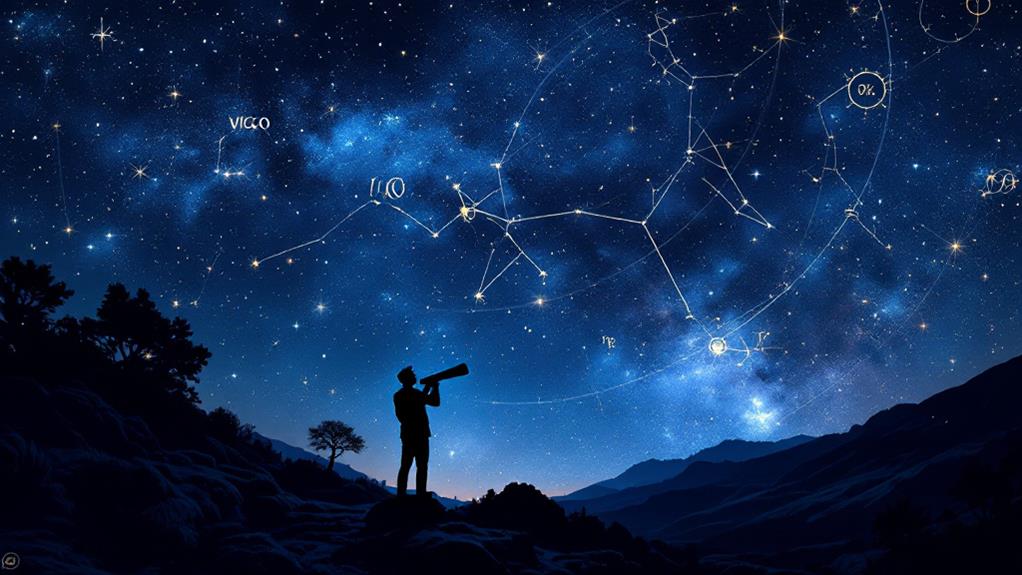
Building on the Renaissance advancements, modern astronomy has revolutionized our understanding of Virgo. Today, you'll find that astronomical measurements and celestial positioning techniques have provided us with precise data about this constellation.
Virgo's significance in modern astronomy extends beyond its mythological roots. Scientists have discovered that it's home to:
- The Virgo Cluster, a massive collection of galaxies
- Spica, one of the brightest stars in the night sky
- Several exoplanets orbiting stars within the constellation
You'll be fascinated to learn that Virgo plays an essential role in our understanding of the universe's structure. It's part of the Virgo Supercluster, a vast collection of galaxy clusters that includes our own Milky Way.
Modern technology has allowed astronomers to map Virgo's boundaries with unparalleled accuracy. Using radio telescopes and space-based observatories, they've uncovered details about the constellation's stars, galaxies, and other celestial objects that were previously unknown.
As you investigate Virgo today, you're benefiting from centuries of scientific progress, allowing you to appreciate its beauty and significance in ways our ancestors could only imagine.
Frequently Asked Questions
How Many Stars Make up the Main Shape of Virgo?
When you gaze at Virgo, you'll notice its main shape consists of about 10 to 12 prominent stars. These form the celestial maiden's outline. As you investigate star grouping patterns, you'll find that different cultures and astronomers have interpreted Virgo's shape slightly differently over time. Modern celestial mapping techniques have refined our understanding of the constellation, but the core stars that make up Virgo's primary figure remain consistent in most depictions.
What Is the Brightest Star in the Virgo Constellation?
Spica, the brightest star in Virgo, shines at magnitude 1.04. You'll find it about 250 light-years away from Earth. This blue-white giant has significant cultural importance across many civilizations. Ancient Egyptians associated it with their goddess Isis, while in Arabic astronomy, it's known as Al Simak al A'zal. You can easily spot Spica as it outshines other stars in the constellation, making it a key reference point for stargazers and astronomers alike.
Are There Any Notable Deep-Sky Objects Within the Virgo Constellation?
You'll find a wealth of deep-sky objects in Virgo. The constellation boasts numerous notable galaxies, including the famous Virgo Cluster. You can spot the bright elliptical galaxy M87 and the stunning spiral M104, known as the Sombrero Galaxy. While Virgo isn't known for prominent star clusters, you'll uncover a few globular clusters like M53 and M68. With a telescope, you'll stumble upon an abundance of distant galaxies in this celestial region.
How Does Virgo's Position Change Throughout the Year in the Night Sky?
You'll notice Virgo's seasonal visibility changes throughout the year. In spring, you'll find it prominent in the evening sky, rising in the east after sunset. As summer progresses, it'll move westward, becoming visible earlier each night. By autumn, you'll catch it in the western sky after dusk. During winter, Virgo's celestial position variation means it's mostly hidden, rising just before dawn. This cycle repeats annually, reflecting Earth's orbit around the Sun.
What Is the Best Time of Year to Observe Virgo?
You'll find the best time to observe Virgo is during its peak viewing season in spring, particularly from March to June. For ideal viewing conditions, look to the southern sky after sunset. You'll see Virgo at its highest point around midnight in April and May. As summer approaches, you'll notice it rising earlier in the evening. Remember, darker skies away from city lights will enhance your viewing experience of this celestial maiden.

